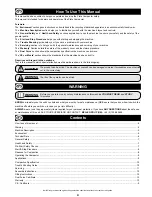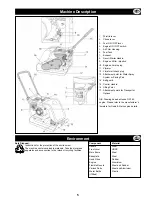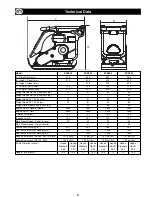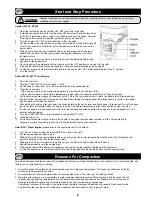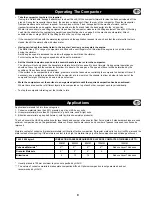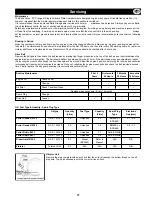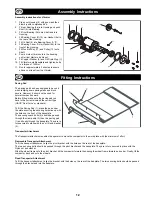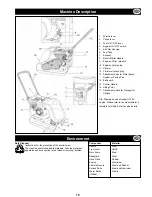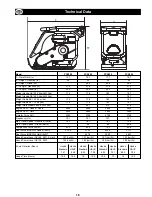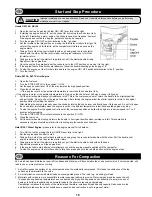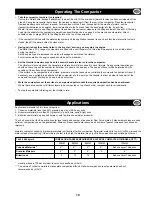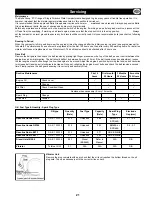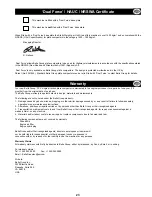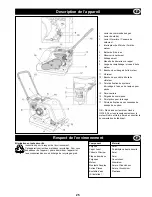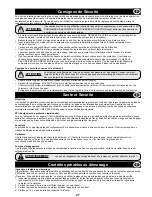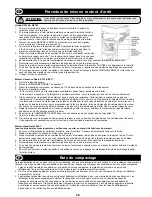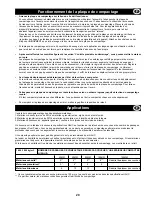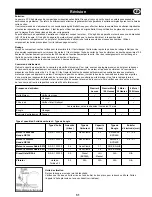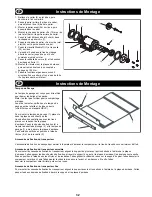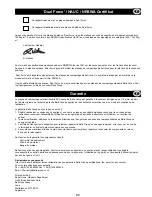
18
Start and Stop Procedure
Honda GX120 & GX160
1. Open the fuel tap by moving the fuel ON / OFF lever fully to the right.
2. If starting the engine from cold, set the choke ON by moving the choke lever fully
to the left. If restarting a warm engine, the choke is usually not required, however,
if the engine has cooled to a degree, partial choke may be required.
3. Turn the engine ON / OFF switch clockwise to the ‘I’ position.
4. Set the throttle to the idle position by moving the throttle lever fully to the right. Do
not start the engine on full throttle, as the compactor will vibrate as soon as the
engine
starts.
5. Taking a
fi
rm hold of the control handle with one hand, grasp the recoil starter
handle with the other. Pull the recoil starter until engine resistance is felt, then
let starter return.
6. Taking care not to pull the starter’s rope fully out, pull the starter handle briskly.
7. Repeat until the engine
fi
res.
8. Once the engine
fi
res gradually set the choke lever to the OFF position by moving it to the right.
9. If the engine fails to
fi
re after several attempts, follow the trouble-shooting guide on page 18.
10. To stop the engine, set the throttle to idle and turn the engine ON / OFF switch anticlockwise to the ‘0’ position.
11. Turn the fuel off.
Robin EX13 & EX17 Petrol Engine
1. Open the fuel cock.
2. Turn the STOP SWITCH to the position ‘I’ (ON)
3. Set the speed control lever 1/3 of the way towards the high speed position.
4. Close the choke lever.
- If the engine is cold or the ambient temperature is low, close the choke lever fully.
- If the engine is warm or the ambient temperature is high, open the choke lever half way, or keep it fully open.
5. Pull the starter handle slowly until resistence is felt. This is the
‘compression’
point. return the handle to its original position
and pull swiftly. Do not pull out the rope all the way. After starting the engine, allow the starter handle to return to its original
position while still holding the handle.
6. After starting the engine, gradually open the choke by turning the choke lever and
fi
nally keep it fully opened. Do not fully open
the choke lever immediately when the engine is cold or the ambient temperature is low, because the engine may stop.
7. To stop the engine, Set the speed control lever at the low speed position and allow the engine to runat low speed for 1 to 2
minutes before stopping.
8. Turn the STOP SWITCH counter-clockwise to the position ‘0’ (OFF)
9. Close the fuel cock.
10. Pull the starter handle slowly and return the handle to its original position when resistance is felt. This operation is
necessary to prevent outside moist air from intruding into the combustion chamber.
Hatz 1B20-7 Diesel Engine
(please refer to the engine manual for full details)
1. Turn ON the fuel by moving the fuel ON/OFF lever fully to the right.
2. Set the engine speed control to start.
3. Taking a
fi
rm hold of the control handle with one hand, grasp the recoil starter handle with the other. Pull the handle until
engine resistance is felt, then let the starter return.
4. Taking care not to pull the starter’s rope fully out, pull the starter handle briskly with both hands.
5. Repeat this procedure until the engine
fi
res.
6. If the engine fails to start after several attempts, consult the engine manual supplied with the compactor.
7. To stop the engine, set the throttle control to idle, then press and hold the red stop button until the engine stops.
Improper maintenance can be hazardous. Read and Understand this section before you perform any
maintenance, service or repairs.
CAUTION
Reasons For Compaction
Soil, which has been disturbed or new in
fi
ll, subbase and blacktop, will have small voids or air pockets which, if not compacted, will
lead to one or more problems occurring.
1. As traf
fi
c crosses the surface of an uncompacted area, the material is compressed. This leads to subsidence of the top
surface as the material
fi
lls the voids.
2. A similar situation occurs with static loads on uncompacted ground. The load (e.g. a building) will sink.
3. Materials with voids are more susceptible to water seepage, leading to erosion. Water ingress may also cause the soil
to expand during freezing temperatures and contract during dry spells. Expansion and contraction is a major cause of
damage to building foundations and normally leads to the structure requiring underpinning.
Compaction increases the density of the material and therefore increases its load bearing capacity. Reduces air voids
and therefore reduces the risk of subsidence, expansion and contraction, due to ingress of water.

